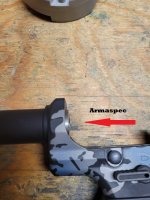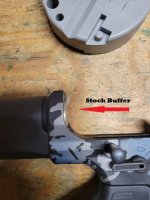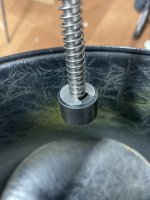So I am running a rifle length buffer, with the Armaspec AR10 Stealth Recoil Spring and spacer. I was having problems with it not going all the way into battery or maybe it went in and bounced out!? But I was getting lite primer strikes randomly. I tried a different bolt, same problem. I removed the buffer retainer pin to allow it to put more pressure on the BCG, same problem. I know you can get shims, but the buffer actually sticks out further than the stock buffer, so it shouldn't need shimmed. Any idea what is going on? FYI when I put the stock buffer and flat wire spring into the rifle, it runs like a champ!
Join the Hide community
Get access to live stream, lessons, the post exchange, and chat with other snipers.
Register
Download Gravity Ballistics
Get help to accurately calculate and scope your sniper rifle using real shooting data.

Install the app
How to install the app on iOS
Follow along with the video below to see how to install our site as a web app on your home screen.
Note: This feature may not be available in some browsers.
You are using an out of date browser. It may not display this or other websites correctly.
You should upgrade or use an alternative browser.
You should upgrade or use an alternative browser.
Armaspec AR-10 Stealth Recoil Spring Problems
- Thread starter mxjoe35
- Start date
If you have a postage scale or similar, I would recommend weighing the Armaspec…just to rule out incorrect buffer weight!
If the stock buffer weight works and rifle cycles properly…that is the weight your rifle needs for a buffer weight, to balance the gas vs. mass and allow the rifle to properly cycle.
If the stock buffer weight works and rifle cycles properly…that is the weight your rifle needs for a buffer weight, to balance the gas vs. mass and allow the rifle to properly cycle.
It would require me to disassemble the Armaspec buffer system, which I don't really want to do. I am just going off of their website, which says equivalent weight of 5.7 ounces. The rifle when it fires cycles properly. It ejects at 3 oclock, just like the other buffer. When I pull the charging handle it feels similar in resistance, maybe even a little more. Because I thought the spring may be under powered and it allowed the bolt to bounce out and not keep it in battery. But it has good resistance. So I am not sure!?
I'm assuming that you're running the matching Aero upper, but I'd still check that the tail of the carrier is centered on the head of the SRS buffer. Also, look for any guide rod interference inside the bore of the carrier.
Just ditch the gucci parts and run this. KISSFYI when I put the stock buffer and flat wire spring into the rifle, it runs like a champ!
If the buffer retainer is correctly positioned, it should never contact the buffer when the gun is assembled. Therefore removing it would not have any effect on the buffer going into battery. If the buffer is in contact with the carrier when in battery, that's all it can do and no amount of imaginary re-positioning can make it work better. The purpose of the internal buffer weights being able to move is to give the BCG a secondary followup tap after returning it to battery. This helps alleviate any bolt bounce.
ETA: It ain't just the WEIGHT of the buffer that does the work, but that second 'forward assist" from the internal weights helps as well. I don't know anything of the Armaspec buffer, but if there are no moving weights inside that may well be your problem. JMO and worth every penny you paid for it
I am running an Aero upper and lower. I will check to see if there is any interference. It seems to cycle smoothly when I pull the charging handle, but I need to do some more testing.I'm assuming that you're running the matching Aero upper, but I'd still check that the tail of the carrier is centered on the head of the SRS buffer. Also, look for any guide rod interference inside the bore of the carrier.
No I get it, what you say is all legitimate! I just wanted to try on because guys swear by them. JP has made a killing of of theirs and JP makes quality stuff. But I will be damned if I can get this thing to work. I will keep tinkering, but for now it's my David Tubbs flat wire spring!Just ditch the gucci parts and run this. KISS
If the buffer retainer is correctly positioned, it should never contact the buffer when the gun is assembled. Therefore removing it would not have any effect on the buffer going into battery. If the buffer is in contact with the carrier when in battery, that's all it can do and no amount of imaginary re-positioning can make it work better. The purpose of the internal buffer weights being able to move is to give the BCG a secondary followup tap after returning it to battery. This helps alleviate any bolt bounce.
ETA: It ain't just the WEIGHT of the buffer that does the work, but that second 'forward assist" from the internal weights helps as well. I don't know anything of the Armaspec buffer, but if there are no moving weights inside that may well be your problem. JMO and worth every penny you paid for it
I know this is an old post, but I had the same issue as above. I struggled trying multiple things/ parts, and just tonight found this post with the exact same issue. I’m just hoping to help anyone else out. I struggled through a few different barrels due to this buffer issue. I was initially attempting to run a 22-250 suppressed. It intermittently failed to go into battery. I had the bolt matched to the barrel, and still had the same issue. Assumed it was something wrong with the settings, headspace, maybe just needed to wear in, or a feed issue due to the body taper of 22-250. Ended up moving that barrel down the road. Went to 243 briefly, and the problems followed. Ultimately I figured it out one day with the rifle in 6GT configuration. The ejector had enough force/ the buffer had too little force to get the bolt all the way into battery. I made a shim to apply more pressure for the small buffer spring. I have not had an issue since. I wish I would have dumped the buffer sooner, but running suppressed I didn’t want to give it up.
Attachments
Anyone get their Armaspec stealth AR10 buffer to work? Solutions? I have one, first time out rifle ran like a clock. Second time I started getting light strikes, then figured out the BCG was not fulling closing and going into battery between rounds. If I manually cycled it, it would. Gas is adjusted to eject at 2:30-3 oclock. I polished and lapped the bolt..... then got thinking it was fine before and then got worse... I took the bolt and tested in another 308 and worked fine, Im guessing now at this point the Armaspec spring is a POS and lost its oomph. If you look at it, its this tiny little thing and makes sense why in its bolt closed state would be the weakest, and then just out of battery it may have lost some tension. A little bit would make a big difference.
There has to be pressure against the bolt when assembled no gap. Not sure if that's going. Check out the JP SCS instructions they make note of that and the different Ar10 buffer tube lengths.
Reassemble the upper and lower assemblies with the front pivot pin and slowly lower the upper into position. Watch carefully as the receivers are closed to verify that the SCS buffer head contacts the bolt carrier. If you are not certain if there is a gap, finish reassembling the rifle and then shake it back and forth gently listening for the sound of the SCS sliding back and forth in the buffer tube. The unit should not be moving freely. The precise length of the SCS was chosen to accommodate most rifles, but if you detect a gap between the bolt carrier and SCS, this is due to slight variations in the manufacturing tolerances of the buffer tube, bolt carrier and receivers. To shim this gap, the best solution we’ve found is to simply place a quarter in the buffer tube before installing the SCS. It will not be necessary to use more than one, and you should not use extra shimming to “preload” the SCS. We offer alternate rate springs for this purpose. If you find the SCS protruding too far out of the buffer tube into the receiver and the rifle is having trouble locking back, you can shorten the plastic spacer as needed, but take care not to remove too much material. The bolt carrier and SCS should be slightly tensioned against each other in final assembly and should not move freely in the rifle. THANKS FOR YOUR BUSINESS! JPSCS-
AR15: Unit does not currently function with any Primary Weapon Systems (PWS) bolt carriers. The back bore on the PWS bolt carriers is not compatible with the JPSCS.
JPSCS-AR10: Unit will not function with longer Armalite carbine-length extension tubes unless the spacer is modified to accomodate the extra length. It will also not function with the HK MR762, the Sig Sauer 716, or the Rock River Arms LAR-8 due to its longer bolt stroke.
Reassemble the upper and lower assemblies with the front pivot pin and slowly lower the upper into position. Watch carefully as the receivers are closed to verify that the SCS buffer head contacts the bolt carrier. If you are not certain if there is a gap, finish reassembling the rifle and then shake it back and forth gently listening for the sound of the SCS sliding back and forth in the buffer tube. The unit should not be moving freely. The precise length of the SCS was chosen to accommodate most rifles, but if you detect a gap between the bolt carrier and SCS, this is due to slight variations in the manufacturing tolerances of the buffer tube, bolt carrier and receivers. To shim this gap, the best solution we’ve found is to simply place a quarter in the buffer tube before installing the SCS. It will not be necessary to use more than one, and you should not use extra shimming to “preload” the SCS. We offer alternate rate springs for this purpose. If you find the SCS protruding too far out of the buffer tube into the receiver and the rifle is having trouble locking back, you can shorten the plastic spacer as needed, but take care not to remove too much material. The bolt carrier and SCS should be slightly tensioned against each other in final assembly and should not move freely in the rifle. THANKS FOR YOUR BUSINESS! JPSCS-
AR15: Unit does not currently function with any Primary Weapon Systems (PWS) bolt carriers. The back bore on the PWS bolt carriers is not compatible with the JPSCS.
JPSCS-AR10: Unit will not function with longer Armalite carbine-length extension tubes unless the spacer is modified to accomodate the extra length. It will also not function with the HK MR762, the Sig Sauer 716, or the Rock River Arms LAR-8 due to its longer bolt stroke.
Messing with it more, I took it out and pressing it on my desk the first 1/4" is weak before it encounters any real spring resistance. Seeing it ran perfect my first time out (once getting gas dialed in) then went to hell.... Im guessing the spring is just junk, there are 2 in it, a fat and a skinny. I emailed Armaspec and will await a reply. I wrote them i'd make a video of it if need be. Maybe it does need spacers, that would make sense, but how it worked perfect before and not now is a mystery. Spacers would put it in good tension when in battery as needed. This buffer is 7.125" long and the buffer tube is 7.25" So spacers might be the fix it. Maybe a couple coins.There has to be pressure against the bolt when assembled no gap. Not sure if that's going. Check out the JP SCS instructions they make note of that and the different Ar10 buffer tube lengths.
Reassemble the upper and lower assemblies with the front pivot pin and slowly lower the upper into position. Watch carefully as the receivers are closed to verify that the SCS buffer head contacts the bolt carrier. If you are not certain if there is a gap, finish reassembling the rifle and then shake it back and forth gently listening for the sound of the SCS sliding back and forth in the buffer tube. The unit should not be moving freely. The precise length of the SCS was chosen to accommodate most rifles, but if you detect a gap between the bolt carrier and SCS, this is due to slight variations in the manufacturing tolerances of the buffer tube, bolt carrier and receivers. To shim this gap, the best solution we’ve found is to simply place a quarter in the buffer tube before installing the SCS. It will not be necessary to use more than one, and you should not use extra shimming to “preload” the SCS. We offer alternate rate springs for this purpose. If you find the SCS protruding too far out of the buffer tube into the receiver and the rifle is having trouble locking back, you can shorten the plastic spacer as needed, but take care not to remove too much material. The bolt carrier and SCS should be slightly tensioned against each other in final assembly and should not move freely in the rifle. THANKS FOR YOUR BUSINESS! JPSCS-
AR15: Unit does not currently function with any Primary Weapon Systems (PWS) bolt carriers. The back bore on the PWS bolt carriers is not compatible with the JPSCS.
JPSCS-AR10: Unit will not function with longer Armalite carbine-length extension tubes unless the spacer is modified to accomodate the extra length. It will also not function with the HK MR762, the Sig Sauer 716, or the Rock River Arms LAR-8 due to its longer bolt stroke.
Also I weighed it and its 8.1oz (entire thing) Website says its 7.09oz. This is the Gen 4.
I put a couple quarters in there, still wont close all the way if you cycle it slowly. Stops at 1/4". Hard to say what its issues is. Have to test fire to see.
Cycling slow tells you absolutely nothingI put a couple quarters in there, still wont close all the way if you cycle it slowly. Stops at 1/4". Hard to say what its issues is. Have to test fire to see.
I recreated the hang up spot, I agree though. I smoothed it out some. If its smoother going slow it might be alright now.Cycling slow tells you absolutely nothing
Similar threads
- Replies
- 46
- Views
- 3K
- Replies
- 91
- Views
- 5K
- Replies
- 3
- Views
- 1K



